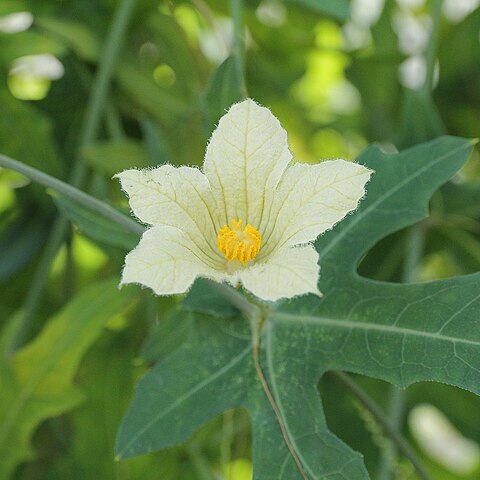male flowers solitary or in sessile or up to 3·5 cm. pedunculate clusters or racemes, when pedunculate usually bracteate and with a co-axillary solitary flower; pedicels of solitary and clustered flowers 0·8–7·5 cm. long, of racemose flowers 1–2 cm. long; bracts small, 1·5–3 mm. long, lanceolate or spathulate. Receptacle-tube 4–5·5 mm. long, campanulate, glabrous; lobes 3·5–5 mm. long, lanceolate, acute. Corolla pale yellow, sometimes with pinkish tinge, green-veined, the lobes 2–3 × 1–1·5 cm., united to above the middle.
A pumpkin family herb. It is a slender perennial climber. It has thick tuberous roots. It grows to 5 m long. The stems are branched and have grooves along them. The leaves are 5 lobed. They do no have a stalk. The edges of the leaves have teeth. The flowers are separately male and female. The male flowers occur in clusters while the female flowers occur singly. The fruit is oblong amd red amd 12 cm long. The seeds are oval and flattened.
Perennial herb; dioecious. Stems climbing. Tendrils simple. Leaves sessile; blade deeply palmately 5-lobed, 30-120 mm in diameter, lobes narrowly ovate-oblong, linear with apices acute, terminating in a mucro, glabrous. Flowers: corolla 20-30 mm long; pale yellow to almost white, sometimes with pinkish tinge, green-veined; Sep.-May. Fruit oblong-fusiform, 60-90 mm long, 20-30 mm in diameter, glabrous, red when ripe.
Leaf-lamina 3–9 × 4–13 cm., sessile, ± amplexicaul, broadly ovate in outline, cordate, ± glaucous, glabrous, smooth or sparsely to densely± strongly scabrid-punctate, deeply palmately 3–5-lobed, the lobes elliptic to lanceolate, entire to coarsely and usually sharply sinuate-dentate or lobulate, sometimes deeply and narrowly so, acute, apiculate.
Female flowers solitary; pedicels 0·7–1·5 cm. long, stout; ovary c. 15–18 × 3·5 mm., cylindrical or ellipsoid-rostrate, glabrous; receptacle-tube 3 mm. long, narrowly campanulate, lobes 3–4·5 mm. long, lanceolate; corolla similar to that of male flowers.
Prostrate or scandent perennial herb. Tendrils simple. Leaves sessile, glabrous. Corolla lobes 20-30 mm long. Fruit often shortly rostrate. Flowers pale yellow, sometimes with pinkish tinge, green-veined.
Fruit 5·5–10·5 × 2–2·5 cm., ellipsoid-fusiform or ellipsoid-cylindrical, often shortly rostrate, bright red; fruit-stalk 0·7–1·5 cm. long, stout, expanded upwards.
Seeds 6·5–7 × 3–3·5 × 1·4 mm., asymmetrically ovate in outline, compressed; testa minutely rugulose.
Stems annual, arising from tuberous subterranean rootstock, prostrate or scandent, glabrous.
Probracts 1·5–3·5 mm. long, small, narrow.
Tendrils simple.

